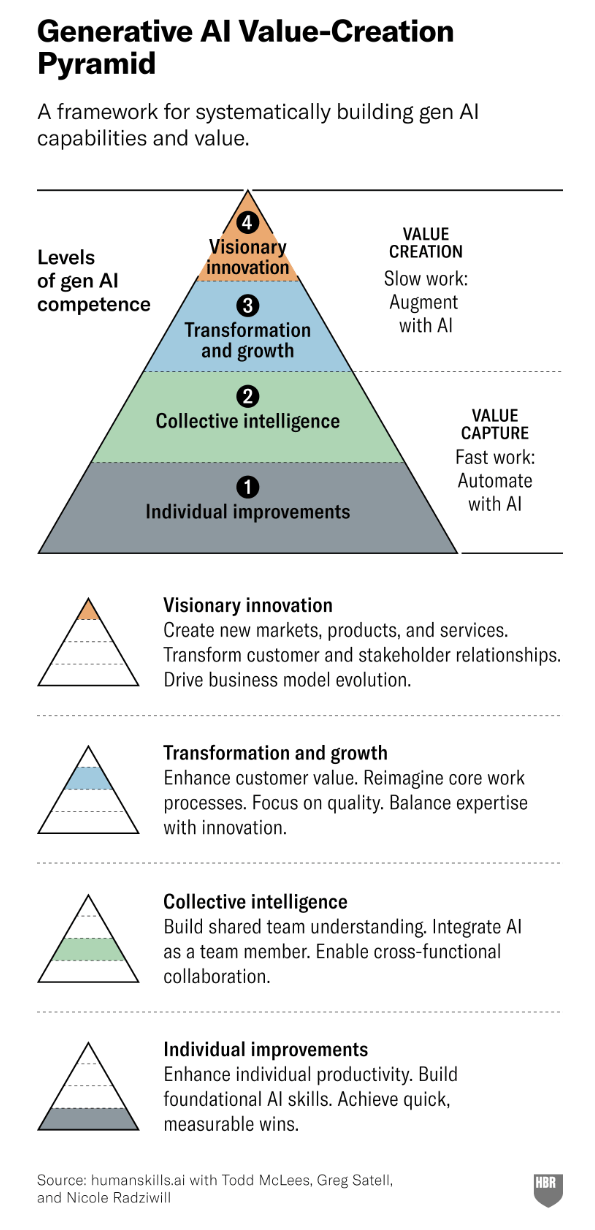
Image Source: ChatGPT-4o
Mastering Generative AI: A 4-Level Framework for Maximum Value
Since the launch of ChatGPT Enterprise in March 2023, businesses across industries have been racing to harness generative AI’s potential. However, while the technology advances rapidly, many organizations struggle to systematically create and capture value.
Most businesses lack a structured approach to generative AI adoption. Common practices—such as providing employees access to AI tools without guidance—result in limited productivity gains. To address this gap, experts have developed a structured framework: the Generative AI Value-Creation Pyramid.
This pyramid helps organizations assess their AI maturity and unlock value through four levels: individual improvements, collective intelligence, transformation & growth, and visionary innovation.
The Generative AI Value-Creation Pyramid The framework consists of four progressive levels, each building on the previous one.
Individual Improvements
Early adoption of generative AI can yield quick productivity boosts for individuals. Research shows significant productivity gains in areas like:
Customer service (34% faster issue resolution).
Software engineering (26% more code delivered).
Data science (10% faster task completion).
While these gains are noteworthy, their overall enterprise impact is often modest without further scaling.
Many organizations remain at this level, where implementing generative AI involves little more than providing employees with access to the technology and basic guidance. While this approach can lead to isolated improvements, the overall impact on the enterprise tends to be minimal. Without broader adoption or strategic integration, businesses risk falling behind their industry peers as others advance.
Collective Intelligence
Generative AI enhances teamwork by bridging gaps in understanding, reducing biases, and improving decision-making together. This allows for significant competitive advantage over the organizations who do not implement GenAI on a team level vs. individual level.
Example: An insurance company used AI to clarify requirements and expectations after a merger, significantly boosting productivity.
Key enabler: Treating AI as a team member with specialized skills, complementing human expertise, to deliver meaningful results and unlock collaborative potential.
Transformation & Growth
While boosting productivity is important, the true potential of generative AI lies in fundamentally rethinking how work is performed. Organizations that advance beyond individual gains and collective intelligence have the opportunity to unlock entirely new sources of value.
Example: The Cleveland Clinic reduced doctors’ documentation time using AI, allowing them to focus more on patient care.
To fully leverage AI’s transformative potential, organizations must strike a careful balance between innovation and responsibility. It is recommended to establish a dedicated space for experimentation, where teams can safely question traditional practices, explore new strategies, and uncover innovative ways to enhance their expertise with generative AI capabilities combined with human oversight.
Visionary Innovation
After establishing the habits and practices to rethink internal processes, you can shift focus to transforming interactions with customers, suppliers, and stakeholders. This is where AI’s potential becomes truly revolutionary, enabling the creation of groundbreaking products and services that can redefine the playing field.
Example: A U.S. R&D lab used AI to boost innovation, increasing discoveries by 44% and patents by 39%.
However, the loss of creativity reported by 82% of scientists underscores the importance of balancing AI with human-centered approaches.
Experience has shown that targeted human skills training can significantly, and sometimes completely, counteract these challenges. By aiming high and identifying the experiences that have the greatest impact on their business, organizations can move beyond individual accomplishments. As they shift focus to scalable efficiencies and delivering customer value, their perspective expands, unlocking even greater potential.
Practical Steps to Apply the Pyramid
Organizations can implement the pyramid framework quickly through these steps:
Discovery (60 minutes): Identify AI use cases across the pyramid levels with cross-functional teams. The focus should be on uncovering use cases that go beyond straightforward productivity improvements, aiming instead for opportunities that can transform team collaboration or enhance customer service (levels 2 and 3).
Prioritization (30 minutes): Focus on high-value, feasible opportunities aligned with company goals. The emphasis is not on speed but on achieving quality improvements that genuinely impact stakeholders.
Build to Learn (90 minutes): High-priority opportunities are immediately advanced to prototype development using existing AI tools like ChatGPT or Copilot.
In just a few hours, organizations can transition from isolated productivity gains to prototypes demonstrating transformative value.
Looking Ahead
The Generative AI Value-Creation Pyramid highlights that sustainable AI success requires more than technology—it’s about equipping people to unlock value collaboratively and responsibly. Organizations that systematically adopt generative AI to enhance teamwork, transform workflows, and drive innovation will lead the way in this transformative era.
Editor’s Note: This article was created by Alicia Shapiro, CMO of AiNews.com, with writing, image, and idea-generation support from ChatGPT, an AI assistant. However, the final perspective and editorial choices are solely Alicia Shapiro’s. Special thanks to ChatGPT for assistance with research and editorial support in crafting this article.

